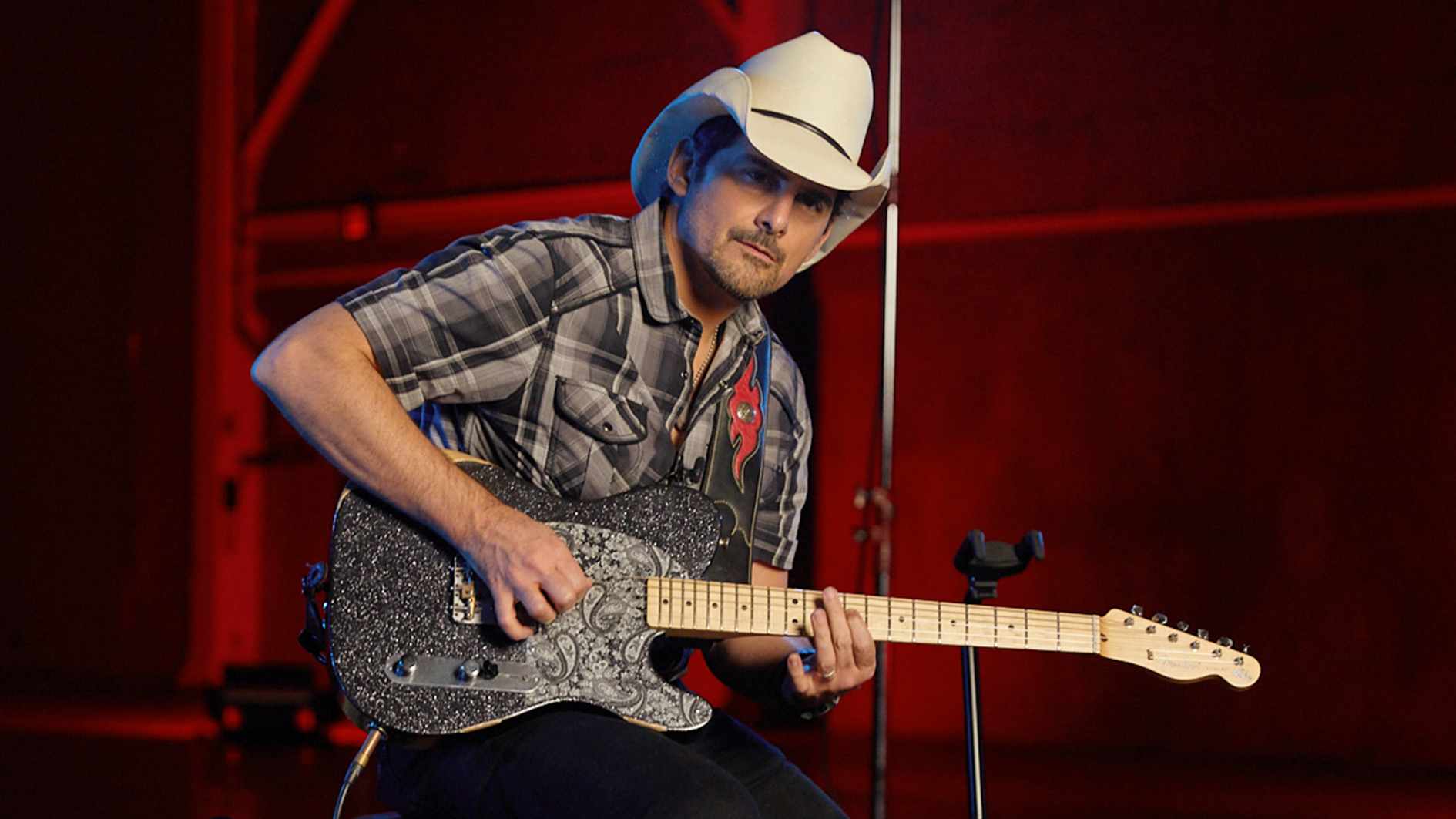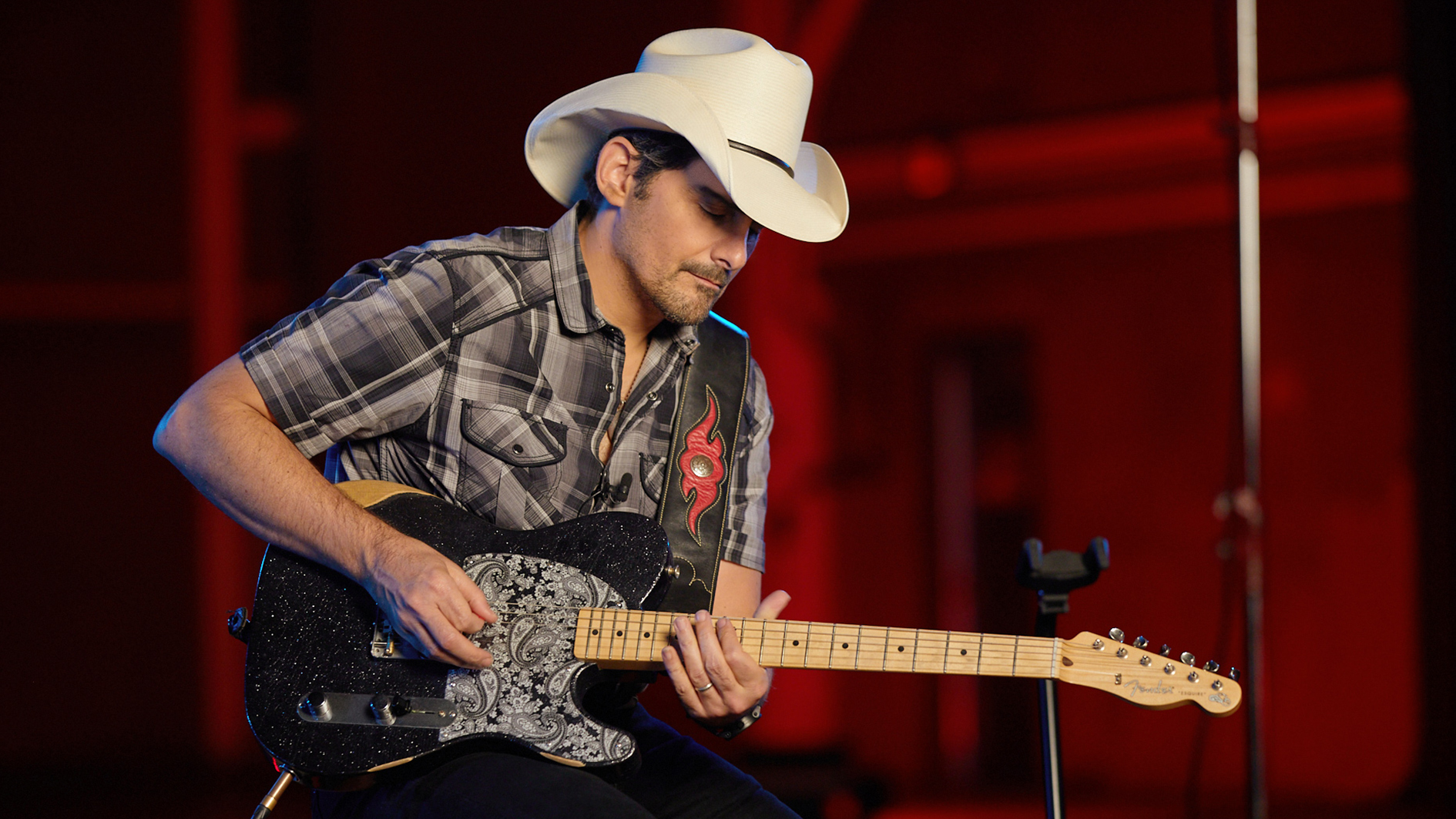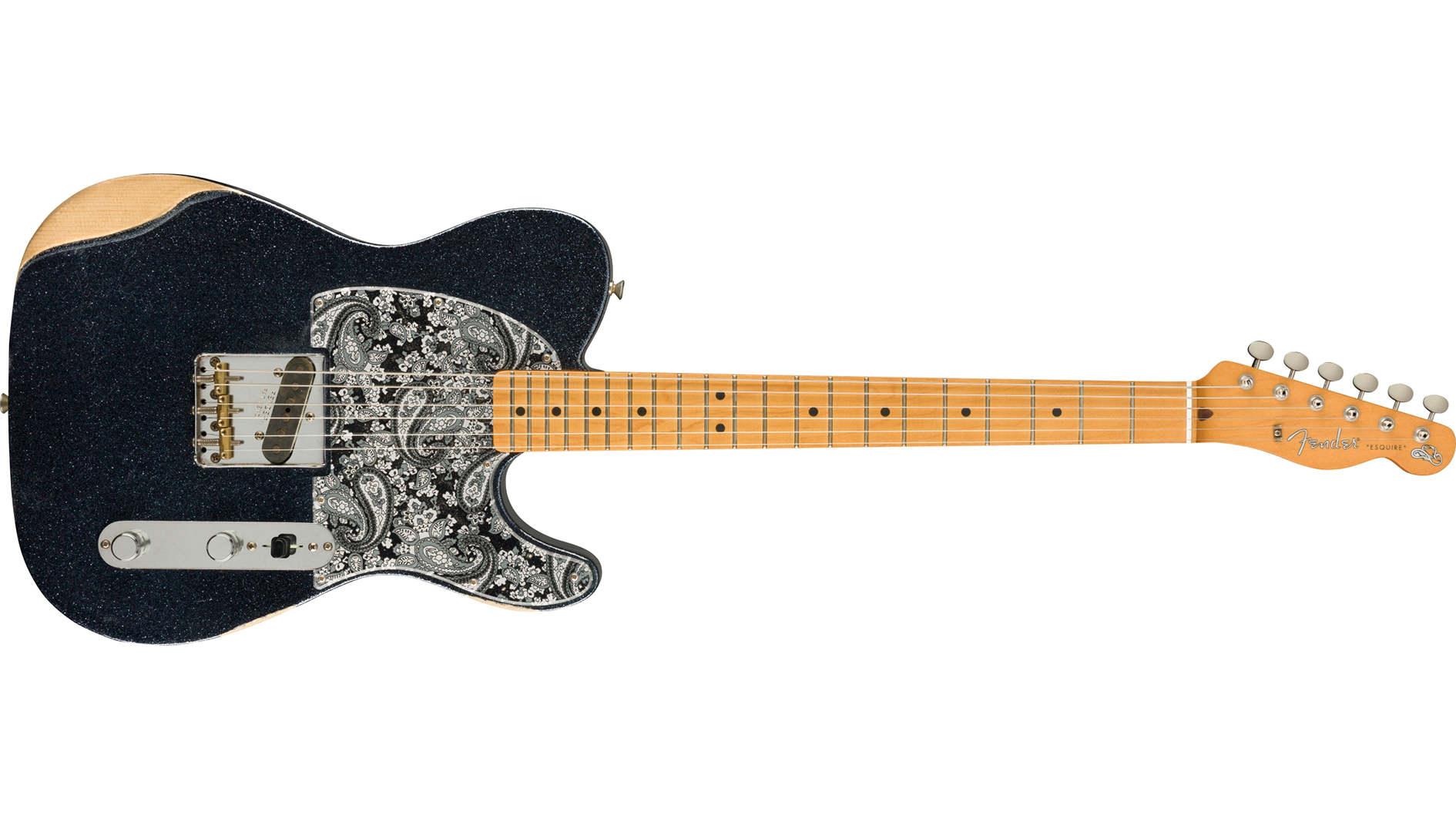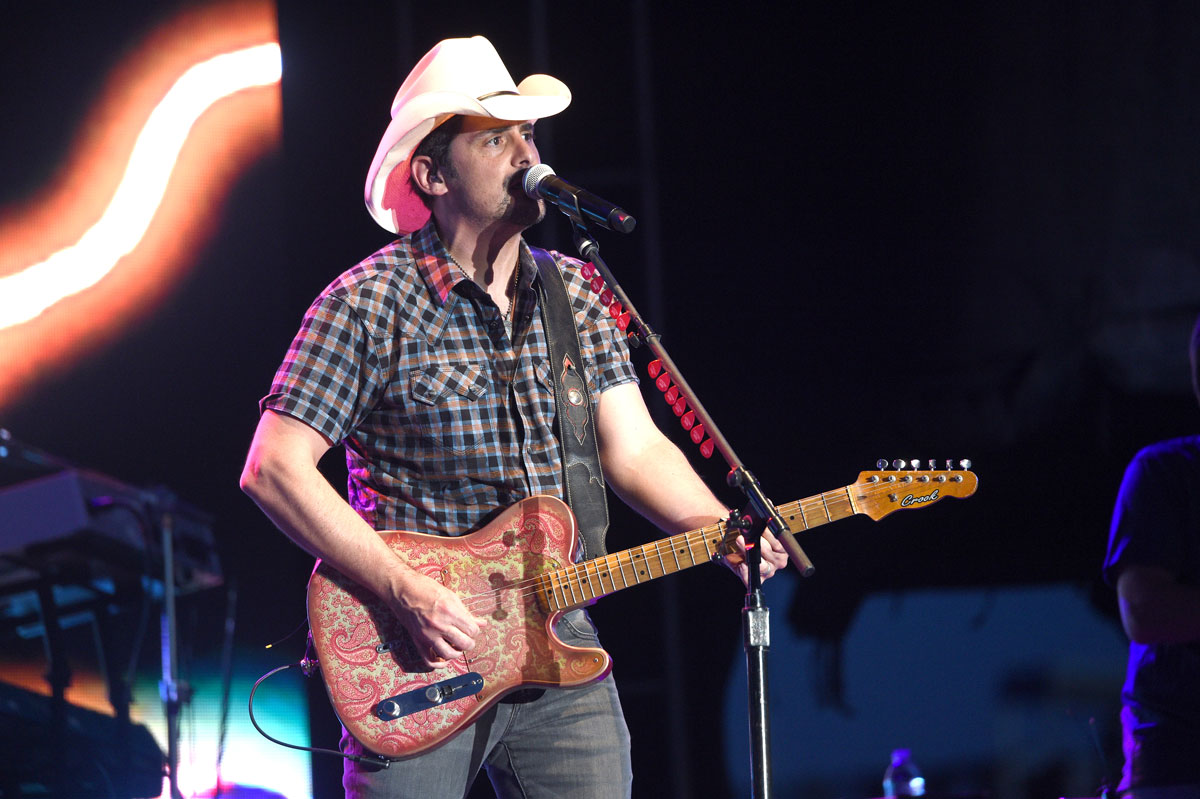Brad Paisley: “I’ve always said that country is jazz on the bridge pickup!”
The country music star on his guitar rig essentials, how he came to develop his secret neck pickup-equipped Fender Esquire, and the similarities between metal, jazz and country…

“It’s been problematic time for us musicians to say the least,” answers Brad Paisley when Guitar World asks how 2020 will be remembered. Right now, he observes, it seems as if things are going to get a lot worse before they can get better…
“We’re in denial as a country... other places are in lockdown,” continues the multiple Grammy-winning modern country star. “We’re acting like it’s normal, and it’s not working. Musicians have all had to rethink what creativity means and of course we’re all used to the live runs that effectively feed us and lead to doing more in the studio.
“The schedules I’ve always kept to in life are sort of anchored in the cities I was supposed to be in around the world. The release schedule would predicate when tours happen and get announced.
“When you take away that simple, basic reason – it becomes more complex. It’s like the chicken or the egg. Does the tour feed the album or the album feed the tour? Take away the tour part and you’re making a record with no thought of how it might work live, it changes the way you create. Yeah… it’s a really weird time.”
There is some cause for celebration, however. The guitarist will be getting another Fender signature – this time a Brad Paisley Road Worn Esquire in Black Sparkle. It will feature a paulownia and spruce body, and a custom enhanced V-shaped maple neck with a 9.5”-radius fingerboard.
But the pickups are where it gets really interesting, with a Seymour Duncan Secret Agent neck pickup sneakily hidden under the black and paisley pickguard, as well as a custom-wound ’64 Tele bridge pickup.
Here the singer/guitarist talks us through his new signature, as well as what else is in the rig and the secrets behind adding country sauce into your leads...
Get The Pick Newsletter
All the latest guitar news, interviews, lessons, reviews, deals and more, direct to your inbox!
The new signature is certainly a different beast to your first one...
“Yeah, we had such success with my Telecaster that we found ourselves wondering how much to change. Initially when Fender got in touch, we were thinking the same Tele but in a different color, so any finish but silver. But then I felt there needed to be a reason for the first one to still exist. How about we created something that made you want both?!
There’s something about having to make all your music with that one rugged pickup. It just feels so industrial
“I think the players who have the money, and already own the silver Tele, will be really into the idea of a new charcoal black Esquire to hang along next to it. They’re bookends in that sense and very unique...”
Especially considering the inclusion of your Secret Agent pickup...
“I went to Seymour Duncan’s factory a few years ago and sat with him, MJ [Maricela Juarez] and a lot of the people there. Seymour’s just the greatest guy. I said I’d played a lot of Esquires in concert because I love the way they feel without that neck pickup.
“There’s something about no magnetic pull on the strings and also the fact that you have to make all your music with that one rugged pickup. It just feels so industrial. Just one slab of wood and one pickup… going back to the original designs when Leo was trying to figure out how to make a block of wood sound okay.

“And as much as I love that, there are times I will be playing an instrumental or song that does call for a neck pickup. If I don’t have a setlist planned out so it all works with the Esquire, there have been times I tried to do the neck thing with a bridge pickup and it just sounds weird.
“So I figured they all have the route, so what if I had something that didn’t sound like any other neck pickup but sounded useful. They came up with this thing, a long ceramic rod that sits right under the pickguard. It doesn’t pull on the strings at all because it’s quite far away.”
What were you looking for in terms of sound?
“To me, it sounds like an early lapsteel pickup that’s sat well away from the strings. Immediately in the testing room, from the very first prototype, we were all like, ‘Holy cow!’ Not only did it sound acceptable, it became my favorite neck pickup. It’s a good three or five dB lower than my bridge pickup. And I like that.
“I don’t like a really beefy neck, I prefer the Stratty kinda tone… and on my Strats, I set my neck pickup real low. I like having more air. I’m not looking for an ES-335 sound. I want it to still be jazzy but more thin.
“So we put that pickup in and it changed everything for me… which is why I went to Fender and said I had this secretly in a couple of my Esquire, suggesting we could put one in and offer it for the first time. Which makes it special, this is the first time anyone can buy an Esquire with two pickups, just one of them hidden. This guitar became an entirely different experience.
I honestly think if we had gone with ash, we would now be struggling to keep up with the weight part of the bargain
“It works so well with the pickup Tim Shaw designed in the bridge. What I love is that it’s so low in output, when you use it with a Tube Screamer or Wampler device for a SRV-style barely broken up sound or some funk thing and then go to the bridge, it almost feels like a humbucker.
“The bridge is so much higher in output. When we were designing this pickup, I was hoping for something at least acceptable in the neck, but it’s not. I just recorded something with it the other day, using this guitar just for the neck sound...”
As for the body, what made you choose paulownia instead of more regular tonewoods like ash or alder?
“The paulownia body works extra well with the spruce because together they have a great acoustic resonance. Bill Crook, a guitar builder who I work with frequently, actually made me a Tele or two out of paulownia. He told me it behaves a lot like light swamp ash and knew I’d love it because I like light guitars in general.
“Sure, I own some great instruments that aren’t typically light. But as a rule, with vintage Teles and particularly the Blackguards and '50s models, the light ones have a magic that is impossible to replace. That’s how I started using that wood.
“When I started working with Fender on the first signature, they said they could guarantee ash would be within a certain range of weight and I instantly told them that would have been too heavy. There is a shortage with lighter ash.
“I honestly think if we had gone with ash, we would now be struggling to keep up with the weight part of the bargain and the guitars would have eventually gotten heavier. Fender came up with the idea of putting a spruce top and back on there...”

Seems to work pretty well for acoustics, right?!
“Exactly. When you think about what spruce does on those greatest old Martins, that thin piece of wood supports everything. The bridge is glued to it, so is the bracing. For some reason, those things have survived so long and sound incredible in terms of resonance.
“The spruce becomes a speaker, almost. So when you stick spruce in there with paulownia, it acts like a speaker that allows you to have some combination of alchemy – which to me is where the magic is.
“These guitars are incredibly light, some have been in the five and change range in terms of pounds, I’ve seen a six or two… but none have been over seven. The consistency is great. The combination of pickups and wood really really works, a bit like an old ‘51 Nocaster that weighs only six pounds.
“I haven’t found a single one of my signatures anywhere, even at meet and greets where I sign stuff, that wasn’t right.”
I’ve done a few last-minute gigs and if I can throw a delay pedal in there with the Wampler Paisley Drive Deluxe, I’m covered. I could do just about everything with those two things
What else would we find on your rig right now?
“I’ve only used the rig three times in the past year [laughs]! But I do have dreams for the rig. There are a couple of things on there I love. Dr. Z came out with the Z-Wreck Junior.
“The Z-Wreck was his collaboration with myself and Ken Fischer before Ken died, it’s an amazing amp. He developed a half power version that’s about 18-Watts, which right now is very useful considering we are all playing concerts in our bedroom.
“Pedal-wise, Wampler did a thing a year or two ago that would be my only desert island pedal when it comes to overdrive, the Paisley Drive Deluxe. It has two pedals in it, one is my Paisley Drive and the other is something called an Underdog, which has the thickness of a fuzz without being fuzz. It’s perfect for the single notes singing type things.
“I’ve done a few last-minute gigs and if I can throw a delay pedal in there with this overdrive, I’m covered. I could do just about everything with those two things.”

You’ve also used Vibro-Kings in the past...
“I just did some videos for Fender with my new Esquire. We set up in a rehearsal space before I played it and talked about it, and I ended up talking about things they don’t make that I’m going to pressure them into making [laughs].
“Basically I have several Vibro-Kings with the baffleboard taken out that I use in combination with the Z-Wreck Junior. It’s the 3x10 setup but with a 12 and a 10 – so I use a Vox Gold 10, which is an amazing speaker that’s their version of a 10 inch, and then the Vox Red which is a bit more woody and midrangey.
“A 12 and 10 in a Vibro-King, with a little mod we did, is pretty amazing… especially if you’re talking about twang and verb. Even talking about it makes me wish I was touring right now. I would be peeling the paint off these venue walls… if we were allowed in!”
There are a lot of open strings and passing tones in country leads which aren’t a million miles away from jazz playing...
I’ve always said that country is jazz on the bridge pickup!
“I’ve always said that country is jazz on the bridge pickup! I know that sounds ironic coming from a guy who has this new neck pickup which is hidden [laughs]. When you think about the ghost notes and passing tones in jazz, all that extra spicy stuff instead of typical pentatonics, you can see how the lines blur.
“On a 335 or Les Paul neck through a clean channel, it’s going to sound very jazzy. But if you switch to that back pickup on a Tele and start plucking away using hybrid picking, those licks become immediately country. Add some slapback delay and that’s it… you will definitely sound like a country player.
“Dann Huff, a friend of mine from Nashille came from the rock world, he played in the band Giant. Then he started appearing on all these Nashville records. He became one of the leading session guys and I know he was just playing metal licks on a clean channel… and it worked.
“Everyone was blown away by what he was doing. If you want to learn country, it’s more of a mindset than changing your scales and modes. It’s about plucking and tone more than what you actually play. A lot of the lines I could play with a pick but there’s something about the muting and punch of hybrid.”
From a rhythmic standpoint, country can often feel unrelenting – as Guthrie Govan once noted, quite similar to death-metal in that regard...
“Yeah! It’s very much like that, but it’s life-metal [laughs]. And that’s right, it’s a really weird thing. Both styles have that rapid-fire machine gun thing. I love throwing my rock influences into parts too – there are even some where I’ve tapped.
“If you listen to the solo on River Bank, there’s a clean solo which leads to a dirty solo with tapping. It’s quite left-field for country. And that’s the beauty of where country is right now, we can get away with things they would have kicked us off the session for back in the day. You can throw all that stuff in without being blackballed [laughs]!”
For more info on the Brad Paisley Esquire, head to Fender.com.
Amit has been writing for titles like Total Guitar, MusicRadar and Guitar World for over a decade and counts Richie Kotzen, Guthrie Govan and Jeff Beck among his primary influences as a guitar player. He's worked for magazines like Kerrang!, Metal Hammer, Classic Rock, Prog, Record Collector, Planet Rock, Rhythm and Bass Player, as well as newspapers like Metro and The Independent, interviewing everyone from Ozzy Osbourne and Lemmy to Slash and Jimmy Page, and once even traded solos with a member of Slayer on a track released internationally. As a session guitarist, he's played alongside members of Judas Priest and Uriah Heep in London ensemble Metalworks, as well as handled lead guitars for legends like Glen Matlock (Sex Pistols, The Faces) and Stu Hamm (Steve Vai, Joe Satriani, G3).
“There’d been three-minute solos, which were just ridiculous – and knackering to play live!” Stoner-doom merchants Sergeant Thunderhoof may have toned down the self-indulgence, but their 10-minute epics still get medieval on your eardrums
“There’s a slight latency in there. You can’t be super-accurate”: Yngwie Malmsteen names the guitar picks that don’t work for shred


![A black-and-white action shot of Sergeant Thunderhoof perform live: [from left] Mark Sayer, Dan Flitcroft, Jim Camp and Josh Gallop](https://cdn.mos.cms.futurecdn.net/am3UhJbsxAE239XRRZ8zC8.jpg)







